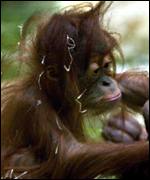|

老虎等物種所面臨的壓力更高
作者:環境通信者Alex Kirby
環境運動團體WWF表示,全球暖化會造成世界上1/3植物與動物棲地的重大變化。
WWF表示,在2100年之前,改變中的氣候也許已經會讓一些物種消失。
在北半球的高緯度地區,受到的影響似乎最為嚴重,失去了高達70%的棲地。
此外,沿岸與島嶼物種受到海洋暖化、海洋水位上升,以及生存地區變化的共同威脅。
WWF表示今日為6億人口與工業化普及的社會,與13,000年之前相去甚遠。近來氣候溫暖化是如此快速,在本世紀會如預期般升高。
「到了那個時候,人類社會可能會有10億人口,而且全部都會是狩獵採集者。農業與城市將不會再繼續存在。」
影響廣泛
在一篇關於全球暖化與動物多樣性下降的報告裡,WWF表示北蘇聯、北歐與加拿大似乎為影響最大的地區。

猩猩的分布範圍縮小
報告指出,北歐的其他部分、亞洲與拉丁美洲的一些地區,會損失將近一半的棲地。
這篇報告的作者之一Adam Markham表示:「當全球暖化加速,植物與動物會受到更大的壓力,它們必須遷移到合適的棲地。」
「有些物種沒有足夠的遷移速度。在一些地方,植物必須以比上一個冰河時期還要快10倍的速度移動,才得以生存下去。」
「對於一些植物與動物而言,全球暖化意謂著滅絕。」
WWF表示受到最大威脅的物種,為稀少、或是生存在孤立以及破碎棲地的物種。範例包括了:
- 稀有的衣索比亞狒狒
- 在墨西哥地區過冬的帝王蝴蝶
- 澳洲的山侏儒袋鼠
小心估計
報告中並指出,美國絕大部分的北方赤松,以及新英格蘭、新紐約州的棕樹林,可能會消失。
這篇報告的預測以估計大氣中的二氧化碳濃度為基準。由人類活動產生的主要的全球溫暖化氣體(二氧化碳),在2100年之前,將會達到工業化前的兩倍。
但是,WWF則表示有些預測,指出以目前的趨勢來看,在本世紀末時,二氧化碳的濃度會高達三倍。
北美馴鹿與其它的北極圈動物面臨生存壓力
報告指出,類似蘇格蘭的巨型山雀與亞利桑那州的墨西哥橿鳥,已經開始將每年的繁殖期提早,而蝴蝶的分布區域則向歐洲北方移動。
許多北極圈的哺乳動物開始感受到冰山下降與苔原暖化的威脅。
相對的,害蟲卻往往佔有優勢。一位美國阿拉斯加林業部的昆蟲學家Ed Holsten,告訴WWF:「昆蟲一直與寒冷戰鬥,當氣候變得溫暖時,它們可以完成兩倍次數的繁殖周期。」
「在最近十年間,溫度幾乎呈指數上升。多年以來,蛀蟲正常為兩年進行一次繁殖周期,現在則是一年就進行一次繁殖周期。」
該是下決定的時候了
政府應該對11月在荷蘭舉行的聯合國氣候高峰會議裡,對1997年 Kyoto協議書做最後決定了。
有些研究者仍然懷疑人類活動是否會導致氣候變遷。他們強調在地球表面取得的溫度記錄的結果,顯示出比上一個世紀更快速暖化,這與衛星及氣象氣球的紀錄相悖。
全文及圖示詳見: http://news.bbc.co.uk/hi/english/sci/tech/newsid_901000/901147.stm
版權歸屬 Ecotrust Website 環境信託基金會(黃曉菊 譯 ,鄭先祐 審校)
中英對照全文:http://news.ngo.org.tw/issue/climate/sub-cc00090501.htm
|
|
Pressure on species like tigers will increase even more
By environment correspondent Alex Kirby
The environment campaign group WWF says global warming could cause fundamental changes to a third of the world's plant and animal habitats.
By the year 2100, WWF says, the changing climate may have driven some species to extinction.
It says areas in high northern latitudes are likely to be worst affected, losing up to 70% of their habitat.
And coastal and island species will be at risk from a combination of warming oceans, sea-level rise, and changes in the areas where they can survive.
WWF says conditions today, in a world of six billion people and widespread industrial societies, are very different from 13,000 years ago, the last time the climate warmed as quickly as it is predicted to heat up this century.
"At that time the whole of human society probably numbered in the tens of millions, and all were hunter-gatherers. Farming and cities did not yet exist."
Effects widespread
In a report, Global Warming and Terrestrial Biodiversity Decline, WWF says northern Russia, Scandinavia and Canada are likely to be among the areas hardest hit.
Orang-utans will find their range reduced
It believes other parts of northern Europe, some of Asia, and some parts of Latin America could lose nearly half their available habitats.
One of the report's authors, Adam Markham, said: "As global warming accelerates, plants and animals will come under increasing pressure to migrate to find suitable habitat.
"Some will just not be able to move fast enough. In some places, plants would need to be able to move ten times faster than they did during the last ice age merely to survive."
"It is likely that global warming will mean extinction for some plants and animals."
WWF says species at greatest risk are those that are rare or that live in isolated or fragmented habitats. Examples include
- a rare Ethiopian baboon
- the Monarch butterfly at its Mexican wintering grounds
- Australia's mountain pygmy possum.
Cautious estimate
In the US, most of the northern spruce and fir forest of New England and New York state could be lost, it says.
The report's predictions are based on an estimate that atmospheric concentrations of carbon dioxide (CO2), the main global warming gas caused by human activities, will double from pre-industrial levels by 2100.
But WWF says some projections suggest a tripling of CO2 levels by the end of the century on present trends.
Caribou and other Arctic animals face stress
Already, it says, birds like the great tit in Scotland and the Mexican jay in Arizona are beginning to breed earlier in the year, and butterflies are moving their ranges northwards throughout Europe.
Many Arctic mammals are starting to feel the effects of reduced sea ice and the warming tundra.
Pests, by contrast, will often benefit. An entomologist with the US Forestry Service in Alaska, Ed Holsten, told WWF: "Insects being cold-blooded, they can complete their life cycle twice as fast when it gets warmer.
"In the last ten years we've had an almost exponential increase in temperature, and the bark beetle that normally has a two-year life cycle many years now goes through its life cycle in one year."
Decision time
Governments are due to take final decisions on rules for operating the 1997 Kyoto Protocol on climate change at the UN climate summit in the Netherlands in November.
Some researchers still doubt that human activities are inducing rapid climate change. They highlight the inconsistencies between the temperature records taken at the Earth's surface, which show rapid warming over the last century, and data produced by satellite and balloon studies.
http://news.bbc.co.uk/hi/english/sci/tech/newsid_901000/901147.stm |
